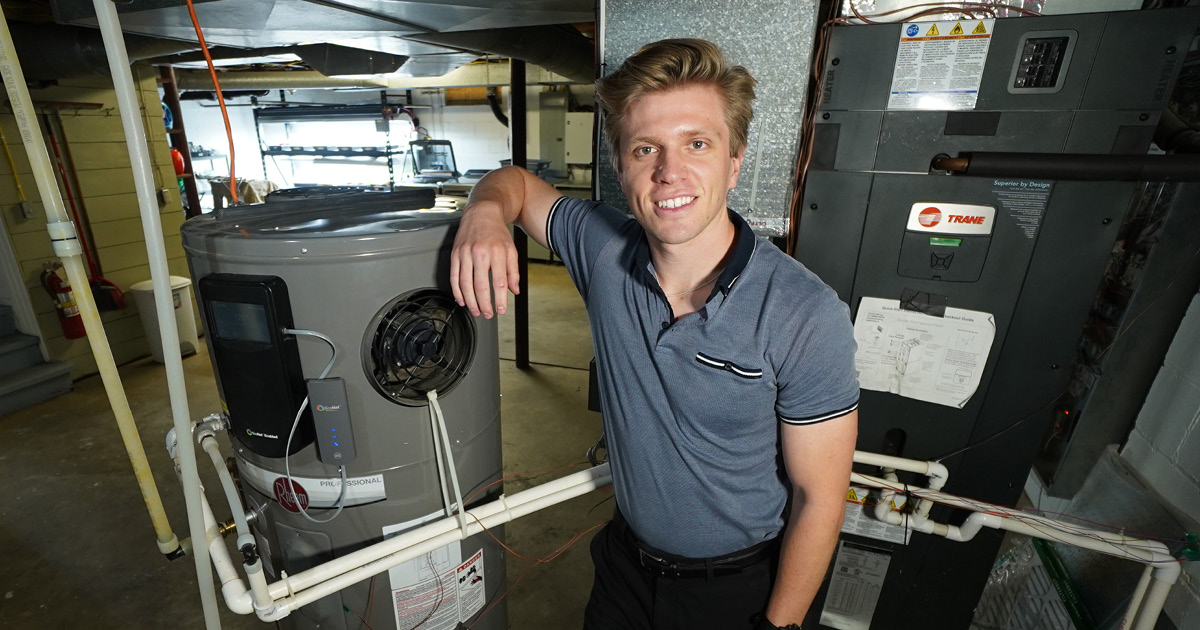Purdue tech predicts water heating usage to improve energy efficiency of residential systems
Patent-pending innovation could save utility companies money by protecting local power transmission equipment
WEST LAFAYETTE, Ind. — Water heater manufacturers and utility service providers may benefit from patent-pending technology developed at Purdue University’s College of Engineering to capture usage data for demand-response programs.
Levi Reyes Premer, a graduate research assistant in Purdue University’s School of Mechanical Engineering, is developing an algorithm that can be integrated with existing water heaters. He said this means water heaters can be remotely managed to reduce peak electricity usage, providing valuable peak reduction services to utilities.
“Electric water heaters significantly contribute to peak electricity demand, especially during high-usage periods,” Premer said. “Controlling electric water heaters to minimize power consumption during peak hours stabilizes the electrical grid, reduces homeowner energy costs and lowers the need for costly infrastructure upgrades.
“While states like California, Oregon and Washington already require demand-response capabilities in new electric water heaters, most current solutions lack the predictive capability needed to maintain comfort while shifting energy use,” he said.
The Purdue algorithm provides an alternative to capture water usage data that is simpler than traditional methods.
“As an alternative to installing an expensive flow meter, our technology estimates water usage with a single additional temperature measurement on the water inlet line,” Premer said. “Since inlet water temperatures don’t vary much between houses or neighborhoods, we need only one new sensor per city.”
Once a water usage profile has been derived per household, a forecast can be developed.
“Water heaters can then be intelligently controlled to shift loads while maintaining user comfort — all at a fraction of the cost and effort of traditional methods,” Premer said. “This can save residents hundreds of dollars on their energy bills over the lifespan of the water heater. Additionally, widespread adoption by utilities has the potential to generate significant cost savings by reducing stress on local power infrastructure, potentially saving utilities hundreds of thousands of dollars.”
Premer disclosed the water usage algorithm to the Purdue Innovates Office of Technology Commercialization, which has applied for a patent to protect the intellectual property. Industry partners interested in developing or commercializing the work should contact Parag Vasekar, business development and licensing manager, at psvasekar@prf.org about track code 71062.
Traditional demand-response drawbacks
Premer said understanding household water usage patterns has become crucial with the rising importance of demand response, wherein utilities encourage people to shift their electricity usage over time to help protect power grid infrastructure.
“Currently, residential electric water heaters rely solely on internal tank temperatures and lack methods to estimate household hot water usage,” he said. “When a demand-response event occurs, these solutions allow tank temperatures to drop significantly, potentially posing issues for residents.”
To ensure comfort while enabling load shifting for demand-response programs, an understanding of hot water usage patterns is necessary.
“With this understanding, water heaters can preheat the tank before a demand-response event if hot water usage is anticipated, avoiding power consumption during the event while maintaining resident comfort,” Premer said. “Effective demand-response integration requires seamless, cost-efficient algorithms that do not disrupt the user experience.”
Premer said more intelligent demand response for electric water heaters has traditionally been challenging. A water heater must shift loads based on predictions of household water usage to maintain comfort. Without insights into these usage patterns, residents may experience cold water during demand-response events, significantly hindering adoption of demand-response-compatible water heaters.
“Currently, a flow meter is needed, or manual inputs from the homeowner are needed, which can be tedious,” he said. “This flow meter can add around $30 to $100 to each unit, which makes it unlikely that manufacturers will add it to their units. That, then, makes it difficult for third-party solutions with the extra labor needed to install the flow meter.”
Premer said the Purdue algorithm eliminates these issues by deriving water flow measurements through the inlet water temperature and inherent temperature readings within all electric water heaters.
“Implementing this requires just one additional inlet water temperature sensor per town or city, costing approximately $10 plus small labor and networking expenses,” he said. “Since this setup is needed only once per area, the overall cost can be divided among hundreds or even thousands of water heater units, greatly reducing the per-unit expense. This enables intelligent demand response where loads are shifted uniquely for each home dependent on their water usage patterns to maintain comfort.”
Algorithm validation and development
The algorithm was rigorously tested in a cold-climate residential setting at Purdue’s DC Nanogrid House in West Lafayette. The house provided real-world conditions, including winter temperatures dropping to -4°F (-20°C).
“Our field tests demonstrated the algorithm’s ability to accurately predict water usage, enabling effective preheating strategies that maintained user comfort even during high hot water usage periods,” Premer said. “The hot water usage estimation algorithm closely matched the real usage with minimal error, validating its reliability and effectiveness. The estimation was within 95%-98% accuracy for a total month of hot water usage.”
Premer will conduct ongoing research into tuning the control algorithms and fine-tuning the techniques to enhance the water draw estimation.
This research was supported by Purdue’s Center for High Performance Buildings and the National Science Foundation.
Findings from this study have been peer reviewed and were published in the 2025 American Society of Heating, Refrigerating and Air-Conditioning Engineers Annual Conference. Premer also spoke at the conference about the study.
About Purdue Innovates Office of Technology Commercialization
The Purdue Innovates Office of Technology Commercialization operates one of the most comprehensive technology transfer programs among leading research universities in the U.S. Services provided by this office support the economic development initiatives of Purdue University and benefit the university’s academic activities through commercializing, licensing and protecting Purdue intellectual property. In fiscal year 2024, the office reported 145 deals finalized with 224 technologies signed, 466 invention disclosures received, and 290 U.S. and international patents received. The office is managed by the Purdue Research Foundation, a private, nonprofit foundation created to advance the mission of Purdue University. Contact otcip@prf.org for more information.
About Purdue University
Purdue University is a public research university leading with excellence at scale. Ranked among top 10 public universities in the United States, Purdue discovers, disseminates and deploys knowledge with a quality and at a scale second to none. More than 107,000 students study at Purdue across multiple campuses, locations and modalities, including more than 58,000 at our main campus in West Lafayette and Indianapolis. Committed to affordability and accessibility, Purdue’s main campus has frozen tuition 14 years in a row. See how Purdue never stops in the persistent pursuit of the next giant leap — including its comprehensive urban expansion, the Mitch Daniels School of Business, Purdue Computes and the One Health initiative — at https://www.purdue.edu/president/strategic-initiatives.













